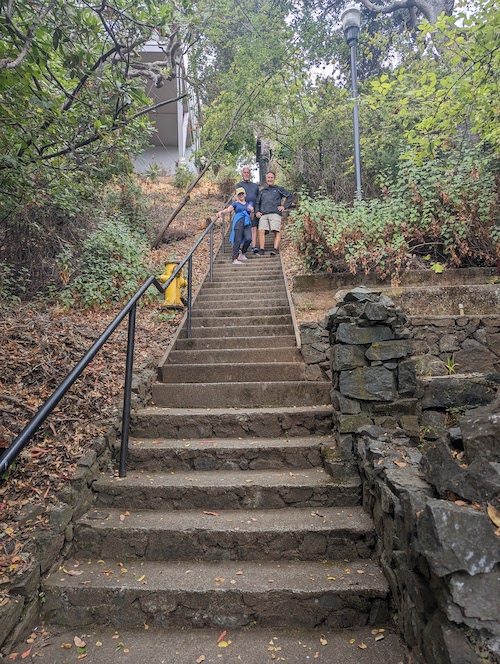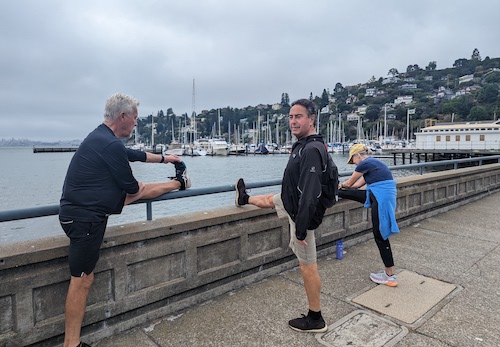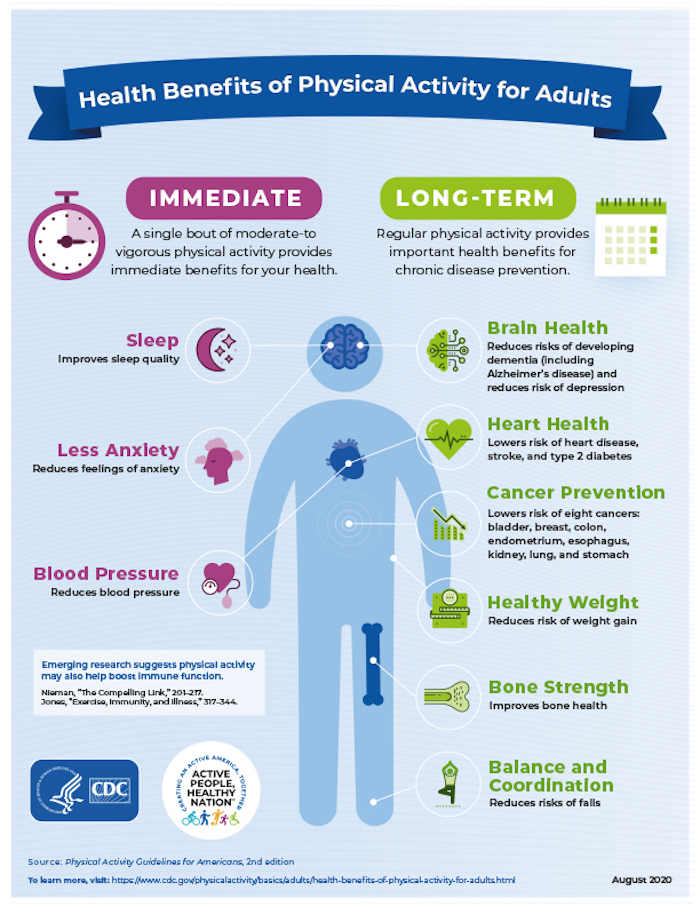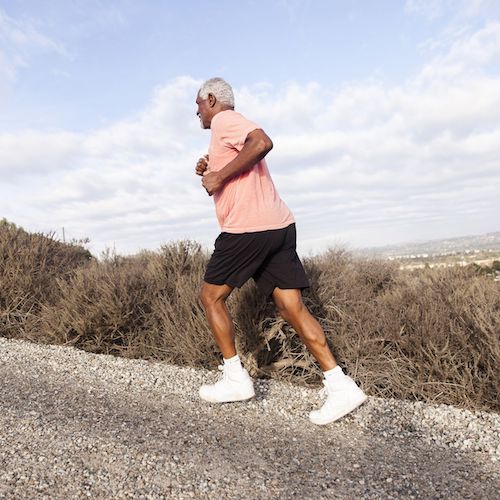Why Walking Is An Ideal Exercise
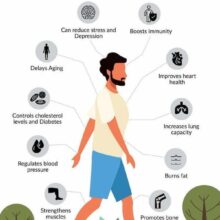
Walking is an ideal exercise simply because it’s very likely that you can do it, wherever you live and (by and large) whatever your physical condition. Improve your health and slow down your aging rate by walking.
Walking is an ideal exercise because you can do it just about anywhere, it doesn’t require more equipment than some clothes and sneakers, and — as you’ll soon see — it does a heck of a lot to keep you healthy and aging better.
Those of us who live in Marin County, California — just north of the Golden Gate Bridge — are fortunate to have an environment that is ideal for walking. We have hills, water views, roads with little vehicle traffic, and trials with none. And, of course, the majestic Marin Headlands, a crown jewel of the Golden Gate National Parks.
Your environment might not be so conducive to walking, but I want to talk you into walking as much as possible, because walking is an ideal exercise that that will pay you valuable dividends throughout your life.
Walking for exercise and overall health is something that many of my friends are well tuned to, and yesterday morning four of us gathered in Tiburon, California, walked the short distance to a land connection to Belvedere Island, and began puffing up the first hill.
As I explain below, we had checked the box on several attributes of walking, recognizing that walking is an ideal exercise for becoming healthy and maintaining it well into old age.
What checked boxes?
These:
- We committed to the adventure the night before, so there was no weaseling out.
- As a group, we could support one another during those step stairs and be entertained by the various stories told.
- We benefited from the “interval training” that the hills and stairs enabled by intermittently boost our heart rates and burning our thigh muscles.
- We were enthralled by the views.
Not even the steep stairs diminished our enthusiasm…
… but nevertheless, some stretching seemed like a good idea afterwards:
Anyway, the Belvedere walk inspired this post, and I hope that this post will inspire you to get out of the house, grab a friend or two and head for the hills, or anyplace you can walk, huff and puff.
Read on to learn why it’s very much in your best interest to do so.
Walking Is an Ideal Exercise because it’s a Powerful Path to Health and Longevity
Walking is an ideal exercise, especially for beginners. It’s a simple yet potent way to improve health and extend lifespan. Recent studies have illuminated the significant impact even a short daily walk can have on reducing premature death. These findings underscore the need for us, as well as public health officials, to prioritize physical activity as a key strategy for promoting overall well-being.
The rest of this section tells you why.
The Power of 10 Minutes
In a groundbreaking study published in JAMA Internal Medicine, a remarkable revelation has emerged: walking for just 10 minutes a day can lead to a significant reduction in premature deaths [1]. (Of course, more minutes is better. As long as you’re out there, go for 30!)
By analyzing data on physical activity and death rates among thousands of American adults, researchers have estimated the potential impact of increased exercise on mortality rates. These findings suggest that if each of us incorporates a mere 10 minutes of moderate exercise into our daily routines, we could collectively prevent over 111,000 deaths annually.
This discovery underscores the immense potential of even slight increases in physical activity to stave off hundreds of thousands of premature deaths over the years to come, including yours.
Exercise and Longevity
The link between exercise and longevity is well-established. Prior research has demonstrated that inadequate physical activity contributes to a significant portion of deaths in the United States. A study by the Centers for Disease Control and Prevention (CDC) revealed that more than 8% of all deaths in the country could be attributed to insufficient levels of activity [2]. Similarly, a British study from 2015 found that individuals who engaged in at least 150 minutes of moderate exercise per week reduced their risk of premature death by 25% compared to less active individuals [3].
The significant impact of exercise on lifespan becomes even more apparent when considering the extreme ends of the spectrum. A study examining the lifestyles and mortality risks of adults in the United States and Europe found that the most sedentary individuals faced up to a 260% higher likelihood of premature death compared to the most physically active counterparts [4].
Read:
- The Best Exercises to Live Longer: Dr. Attia’s Outlive, Part 2
- Get Stronger as You Age — Why and How
Realizing the Potential of Movement
Historically, much of the research into the relationship between exercise and longevity relied on self-reported data, and often used ambitious exercise guidelines as benchmarks. However, a study published in 2020 by JAMA took a novel approach by focusing on the potential outcomes of increased movement, irrespective of meeting formal exercise recommendations. In that study, researchers from the National Cancer Institute and the CDC examined data from the ongoing National Health and Nutrition Examination Survey, gathering information from thousands of participants. They categorized individuals based on their daily activity levels and explored scenarios involving extra exercise.
The results were striking.
Incorporating an extra 10, 20, or 30 minutes of moderate exercise into daily routines yielded a tangible reduction in mortality rates. As I mentioned earlier, an additional 10-minute walk per day was projected to prevent over 111,000 deaths annually. Doubling the exercise time to 20 minutes increased this number to 209,459, and tripling it to 30 minutes a day averted a staggering 272,297 deaths, which represents almost 17% of typical annual death totals.
The implications of these findings are far from abstract; they hold the potential to spare yourself and loved ones from premature deaths and enrich communities at the same time.
Benefits of Walking from a Health, Disease-Prevention, and Aging Perspective
If I haven’t yet convinced you that walking is an ideal exercise, I have a lot more compelling reasons to support my assertion — 11 reasons in fact.
1. Cardiovascular Health
Regular walking has been linked to improved cardiovascular health. Studies have shown that walking can help lower blood pressure, reduce the risk of heart disease, and improve overall heart function. A meta-analysis of 18 studies published in the journal Circulation found that walking significantly reduced the risk of cardiovascular events [5].
Read my posts about heart health.
2. Weight Management
Walking is a simple and effective way to manage weight. It burns calories, and consistent walking can contribute to weight loss and weight maintenance. A study published in the journal Obesity found that regular walking combined with a healthy diet led to significant weight loss [6].
Read my posts about how to lose body fat.
3. Diabetes Management
Walking can improve insulin sensitivity and help manage blood sugar levels. A study published in the journal Diabetes Care demonstrated that brisk walking for 30 minutes a day significantly improved glycemic control in individuals with type 2 diabetes [7]
Read my post on controlling blood sugar.
4. Mental Health and Mood Enhancement
Walking has positive effects on mental health, reducing symptoms of anxiety and depression. It promotes the release of endorphins, which are natural mood enhancers. A study published in the American Journal of Preventive Medicine found that walking was associated with a lower risk of depression [8].
5. Bone Health
Weight-bearing activities like walking stimulate bone growth and help maintain bone density, reducing the risk of osteoporosis, which can lead to life-threatening falls in the elderly.
Research published in the Journal of Bone and Mineral Research highlighted the positive effects of walking on overall bone health [9].
6. Joint Health and Mobility
Walking is a low-impact activity that can improve joint health and flexibility. It helps lubricate the joints and maintain their range of motion. A study in the American Journal of Medicine reported that regular walking was associated with reduced risk of disability in older adults [10].
7. Cancer Risk Reduction
Some studies suggest that walking regularly — at least 150 minutes of moderate-intensity or 75 minutes of vigorous-intensity activity per week, which can be accomplished by vigorous walking, especially up hills — may help reduce the risk of certain types of cancer, including breast, colon, endometrial, prostate and lung cancers [11],[12],[13].
8. Longevity and Aging Well
Regular physical activity, including walking, is associated with increased life expectancy and a higher quality of life as one ages. A study published in the British Journal of Sports Medicine found that walking at a brisk pace was associated with a longer life expectancy [14].
Read my posts about reducing your biological age.
9. Improved Sleep
Engaging in regular physical activity like walking can lead to better sleep quality and help regulate sleep patterns. A study published in the Journal of Sleep Research found that regular walking improved sleep quality and reduced the time it took to fall asleep [15].
Read my posts about getting restorative sleep.
10. Reduces Pain
Walking helps decrease symptoms of chronic pain, making it a great activity for those with joint problems or low back pain. A study published in the Journal of Geriatric Physical Therapy found that walking was an effective way to reduce chronic pain in older adults [16].
11. Boosts Immune System
Walking can boost the immune system, which is important for disease prevention. A study published in the British Journal of Sports Medicine found that regular walking can boost the immune system and reduce the risk of chronic diseases [17]
Read my posts about boosting your immune system.
Inject Variety and Intensity into Your Walks
Just in case you may think that walking is boring, I want to challenge you to consider all the things you could do to make walking an ideal exercise by making it inspiring.
Check out the following ideas and try a few out.
Interval Walking
Incorporate intervals of brisk walking followed by slower-paced walking. This adds variety and increases the intensity of your walk. As will hills!
Nature Walks
Walk in parks, nature trails, or near bodies of water. Connecting with nature enhances the enjoyment of walking and provides a refreshing change of scenery.
Social Walking
Walk with friends, family, or join walking groups. Social interaction can make walking more enjoyable and help you stay motivated. One fun idea is to gradually increase the walking pace until you and your friend(s) can no longer comfortably chat with each other. (This is called “Zone 2 training“.)
Urban Exploration
Explore your city or neighborhood on foot. Discover new streets, landmarks, and hidden gems while getting your steps in. Visual variety can take your mind off of the huffing and puffing.
Walking Meditation
Practice mindfulness while walking. Focus on your breath and the sensations of each step to combine the benefits of walking and meditation. That said, I recommend first walking with some vigor to get the cardiorespiratory benefits, and then go grab some serenity with walking meditation.
Music or Podcasts
Listen to music, audiobooks, or podcasts during your walk. This can make the time pass quickly and add an element of entertainment.
Nordic Walking
Use walking poles to engage your upper body muscles and increase the intensity of your walk. This is especially beneficial for cardiorespiratory fitness.
Walking Challenges
Set goals and challenges for yourself, such as walking a certain number of steps per day or completing a specific walking route. Your compliance is likely to be higher if you do this challenge with a friend.
Walking Games
Turn your walk into a game by challenging yourself to find certain objects, landmarks, or street names along your route.
Incorporate Bodyweight Exercises
Add bodyweight exercises like lunges, squats, or calf raises at intervals during your walk to enhance muscle engagement for stronger muscles and better cardiorespiratory fitness.
A Call to Action
The message conveyed by all the studies I’ve referenced is clear — the power to enhance our health and extend our lives is within our grasp.
A commitment to incorporate modest increments of movement into our daily lives, such as regular walking, can have a profound impact on reducing premature deaths and fostering a culture of well-being.
So, let’s make a conscious effort to integrate 30 minutes of walking or moderate physical activity into our daily routines. Let’s encourage our friends, colleagues, and loved ones to do the same.
In a world where seemingly small choices can yield substantial benefits, a little additional physical activity can indeed have a huge impact. As we step forward, each stride becomes a gesture of self-care and a promise of a longer, healthier life.
Walking is an ideal exercise that not only benefits our bodies but also enriches our lives.
Just ask the four of us.
Last Updated on February 25, 2024 by Joe Garma






